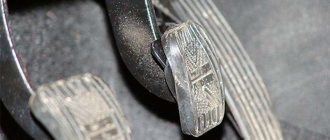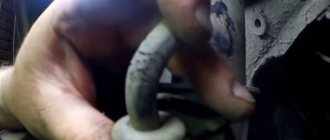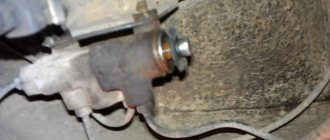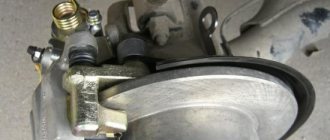Brake bleeding is required in the following cases:
You noticed that the brake pedal has become “softer” and its travel has increased. You have repaired or serviced the brake discs, replaced the brake pads, or completely tuned the brake system.
In these cases, it is definitely necessary to bleed the brake system to remove air. Procedure for bleeding the brakes
As always, you have a choice of how to level up. You can contact a car service. There you will be bled using a brake bleeder. A modern and efficient unit designed to remove air from the brake system. The professional brake bleeding device is equipped with adapters that allow it to work with many existing models of cars and trucks.
The second option is to bleed the brakes yourself. In principle, the procedure for bleeding the brakes is the same for any system. You will need a simple homemade device for bleeding the brakes from a syringe, tubes (hoses) and a plastic container. Options for pumping yourself: two people or one person, i.e. you yourself.
Scheme for bleeding the brakes: you should start from the wheel that is located at a far distance from the GTZ.
- rear right wheel mechanism;
- front left wheel mechanism;
- rear left wheel mechanism;
- front right wheel mechanism.
Bleeding the brakes with a partner
Remove the plug that covers the brake bleeder fitting and put a transparent hose on it. We lower the free end of the hose into a container partially filled with brake fluid.
The partner presses the brake pedal with intensity 3-4 times and leaves it pressed. You slightly unscrew the bleeder nipple until the brake fluid begins to be forced into the container. You can determine the presence of escaping air by the bubbles in the liquid in the container.
After this, tighten the bleeder fitting and repeat this procedure in the same order on the other wheels. Replace or add brake fluid of the type recommended by the car manufacturer. If after bleeding the brake pedal is still “soft”, check the wear of the brake pads, or repeat the bleeding procedure again.
Bleeding brakes without a partner
This task is quite labor-intensive, but sometimes this happens. As a device for bleeding the brakes, you will need: a brake fluid reservoir cap identical to yours, a syringe and a container. Here's the design:
We seal the syringe into the reservoir cap using a “sealant”, then screw this device onto the brake reservoir, having first filled the syringe with brake fluid. We unscrew the fitting at the outlet of the circuit that is to be pumped. We install a container to collect the leaking brake fluid. Then use a syringe to inject brake fluid.
Another way to bleed the brakes without an assistant will require you to have a block or other support. After filling the brake reservoir, you pump the brake pedal several times and hold it depressed. Then perform the standard procedure: unscrew the fitting and wait until the flow of brake fluid becomes slightly uniform. Close the brake bleeder screw.
Release the brake pedal and repeat the procedure. After bleeding the brakes, add brake fluid of the required grade. All. You can go for a test drive of the brake system, while observing safety precautions.
Also:
1. Unscrew the cap on the brake fluid reservoir. 2. I add brake fluid to the reservoir until it is full and screw on the cap of this device. 3. We connect the pump tip (on the hose) to the inflated spare tire. Now, if there is a compressor, I connect it directly to it, and set the pressure in the system to 3 bar. 4. We carry out pumping as indicated in the first post.
The features of this pumping boil down to monitoring the brake fluid in the reservoir.
Continuing the topic, answering the question about the need for a running engine when bleeding brakes with ABS. There is no difference, it has been checked several times, I bleed with the engine running and consider this bleeding to be correct, some simply remove the fuse responsible for the ABS and bleed, others do this with the engine not running. Excerpt from an article on bleeding the brake system with ABS.
Bleeding brakes with abs
Thanks to technological progress, almost all modern cars have a braking system with ABS function. The automatic locking system protects the vehicle's wheels from locking during emergency braking by controlling their rotation speed. Thus, the wheel sensors transmit impulses to the ABS electronics unit, the reaction of which regulates the entire braking process.
Monitoring the health of the car, including the brake system, is very important. Bleeding ABS brakes is necessary to remove excess air from the hydraulic drive, which could get there during repairs or replacement of brake fluid. The presence of air in the mechanisms is unnecessary, because it negatively affects the operation of the brakes. You can determine the need for bleeding yourself by pressing the brake pedal several times. If, when you press the pedal, you feel it is too smooth and moves harshly, then it is necessary to restore the tightness and bleed the brake system of your car. This can be done both with the help of specialists and on your own. Use only new brake fluid, and only one that meets the technical specifications of your car.
Anti-lock braking system ABS: types, types
Depending on the type and type, ABS is classified into:
- One scheme of operation of the ABS system is when all the devices that make up the ABS are located in one unit. That is, the hydraulic valve block, hydraulic accumulator and pump are located in one unit.
- The second ABS scheme is when the component devices (hydraulic valve block, hydraulic accumulator and pump) are located in different places. In this type of braking system, in addition to the ABS module, there is also an ESP module and an SBC module.
Whether you can bleed it yourself depends on the type of brake system in your car.
If the car has a system of the first type, then it is easy to properly pump the ABS.
If the car has a system of the second type, then one cannot cope without a scanner; it needs to be pumped to a service center for maintenance.
The ABS system consists of:
- Sensors (installed on the hubs). When replacing rear wheel hubs, as well as some front ones, you may notice special recesses for sensors. They are engaged in transmitting data about the speed of movement.
- Control valves (installed in the brake system). Serve to change the pressure in the system.
- The electronic unit. Receives speed information from sensors and adjusts control valves.
When to change the brake fluid in a car
Brake fluid (FL), like any other, is characterized by a number of key operating parameters. One of them is its boiling point. It is about 250 0 C. Over time, after long-term use, this figure can decrease significantly. This phenomenon is due to the fact that the brake fluid is quite hygroscopic, and moisture, one way or another penetrating into the brake system, gradually reduces its performance characteristics.
In this regard, the threshold for its boiling sharply decreases, which can lead to serious consequences, including brake failure. The fact is that the operating temperature range of the fuel fluid is 170 - 190 0 C, and if the percentage of moisture in it is high, under certain conditions it will simply begin to boil. This will inevitably lead to the appearance of air pockets, due to which the pressure in the system will be insufficient for effective braking.
Referring to the requirements established by the regulations, replacement of the TJ should be carried out at least once every two years. If you take into account the mileage of the car, the approved regulations indicate that its value should not exceed 55 thousand km.
It is worth noting that all presented standards are advisory in nature. To know for sure whether the fuel tank can be replaced or not, you need to use special diagnostic equipment.
Read also: Mounting a radar detector on a torpedo
A so-called tester can be used as a diagnostic device. It helps determine the percentage of moisture content in the fluid and allows you to judge whether it is advisable to continue using it or whether it should be replaced.
It is worth remembering that among the presented devices there are both universal testers and those that are designed to work exclusively with specific types of fuel fluids.
How to properly bleed ABS brakes
To achieve a good result, you will need an assistant, with whom you first need to bleed the line of the front wheels, then the rear ones.
Important! There may be high pressure in the system, up to 180 atmospheres, so you must first relieve the pressure.
You can bleed, that is, reduce the pressure by discharging the pressure accumulator. To discharge the pressure accumulator, you need to turn off the ignition and press the brake pedal many times (about 20 times).
After this, you need to disconnect the tank connectors. If suddenly, while driving, in a front-wheel drive car, bad sounds begin in the area of the front wheels: grinding, crunching sounds, then these are most likely signs of a CV joint malfunction.
What is the difference between bleeding brakes with ABS and without ABS?
Bleeding the brakes on a car with ABS is not an easy task, and the problem is not the complexity of the pumping process itself, but rather a lack of awareness. Bleeding brakes on a vehicle with ABS and without an anti-lock braking system differs significantly in some key points and has its own characteristics.
Three main differences between an anti-lock braking system and a conventional brake:
- In an ABS system, unlike non-ABS brakes, the piping system (the rear wheel circuit) is under increased pressure.
- The presence of an anti-lock braking system requires regular monitoring of the brake fluid level. If its level is at an extremely low level, the drive pump runs dry and begins to pump only air, thereby quickly stopping functioning.
- The operating time of the pump should not exceed two minutes, but if it has worked longer, it is necessary to turn on the ignition for ten minutes to cool it down.
ABS bleeding sequence
- First, we look for and remove the fuse in the fuse block that is responsible for the operation of the anti-lock braking system.
- Next, we jack up and remove one front wheel, and look for the brake wheel cylinder (BWC) fitting.
- After this, we put a hose on the fitting (from the hydraulic level, for example).
- Open the fitting one turn.
- One presses the brakes all the way and holds it in that position.
- Now turn the ignition key to turn on the hydraulic pump (the ABS indicator lights up on the instrument panel).
- The second person watches how air is removed through the hose and, after removing the air, tightens the fitting.
- We release the pedal only after tightening the fitting.
- Now, how do you know that all the air has escaped from the ABS? This shows the ABS icon on the dashboard, if it goes out after removing the air and tightening the fitting, then all the air has escaped.
The correct sequence for bleeding the ABS system
There is a specific order for properly bleeding an ABS system: right front wheel, then rear, then rear right, and then rear left wheel. If during such work the fuel fluid leaks out of the system, it is necessary to fill the system with new fluid. And to do this, you need to know what fluids can be mixed and how much brake fluid is needed for replacement.
Sequence of operation for the front wheels:
- Turn off the ignition (key position “0”).
- Remove the terminals from the brake fluid reservoir.
- Take a bottle with a small amount of brake fluid and a hose. We lower one end of the hose into the liquid, put the second on the fitting and open the fitting with an open-end wrench. It is advisable to use a transparent hose from the hydraulic level so that you can see whether air bubbles are coming out or not.
- Press the brake pedal and hold it in this position.
- The second person (at the wheel) looks to see if the air is coming out, and after the air bubbles have stopped coming out, he closes the fitting with a key.
How to bleed rear wheels with ABS:
The procedure differs for pumping the rear wheels. After the front wheels, the rear right wheel should be pumped in the following sequence:
- We also put the hose into the bottle of liquid and into the caliper fitting.
- Depress the brake pedal all the way.
- Turn the ignition key to position “2”.
- Hold the brake pedal until the hydraulic pump completely expels the air bubbles.
- Close the fitting and release the brake.
For effective bleeding, when working with the brake system of the rear left wheel, the procedure must be adjusted. Namely:
- As in other cases, put on the hose and unscrew the caliper fitting 1 turn. When pumping with the rear left wheel, the brake does not need to be applied immediately.
- Turn the ignition key to start the hydraulic pump.
- After the air comes out, press the brake pedal halfway and close the fitting.
- Next, release the brake and wait for the hydraulic pump to turn off.
- Turn off the ignition.
- We connect the disconnected connector of the TJ tank.
This video shows how to bleed anti-lock brakes on Audi A4, Audi A6, Volkswagen Passat B5 and others.
Additional elements of brake circuits
The disadvantage of old brakes was that one or more wheels would lock when the pedal was pressed to the floor. As a result, the car lost control and skidded, especially on slippery roads. Later, the traditional system was modernized by adding the following elements:
- hydraulic valve block;
- electric pump;
- capacity - hydraulic accumulator;
- wheel rotation sensors;
- electronic control module (ECU).
The listed components and parts are components of the anti-lock braking system. Thanks to them, a car with ABS never skids, since the automatic system simulates repeated sharp presses on the brake pedal, although the driver presses it all the way.
There are 2 types of brake circuits on cars: three- and four-channel. In the first case, the front wheels are connected to the main brake cylinder by separate branches, and the two rear wheels are connected by a single circuit. In the second scheme, each wheel has its own liquid line.
To understand the difference between bleeding a brake system with ABS, it’s worth understanding its operation:
- When the driver brakes under normal road conditions, the sensors on the wheels record approximately the same deceleration (taking into account turning) and the ABS does not manifest itself at all.
- When you press the pedal sharply, one or more wheels lock and rotate slower than the others, which the sensor reports to the ECU.
- At the command of the controller, the hydraulic unit opens the corresponding valve and the pressure in the circuit of the stopped wheel drops. Excess brake fluid flows into a storage tank.
- The pads release the disc (or drum) and the wheel spins along with the rest. But since the goal is to brake quickly, the ECU switches the valves again, the pads “grab” and hold the disc until the sensor detects the lock again. The cycle repeats until it stops completely.
- To prevent pressure in the master cylinder from dropping during valve actuation, an electric pump replenishes the brake fluid by pumping it from the hydraulic accumulator.
One described cycle takes a fraction of a second. The interaction of the fluid circuits with ABS is felt when the pedal is fully depressed. Due to the rapid operation of the valves and the pumping of fluid, the driver feels a series of shocks.
Conclusion
After carrying out repair and maintenance work on critical components of the car, before driving, you must first check the tightness of the system and the operability of the vehicle components.
ABS - Anti-lock Braking System is a system against wheel locking during heavy braking. Thanks to the fact that ABS prevents the car from skidding along the road, safety increases in emergency situations. The anti-lock braking system will operate correctly if the system is not air-filled.
Watch this helpful video. Tests show that even a working ABS system turns off at the end of the braking distance, so you still need to modify it with your foot.
0
Author of the publication
offline 1 month
Types of ABS system on Toyota cars
There can be two of them, with differences in design and pumping methods:
- ABS consists of a hydraulic valve block, a pump and a hydraulic accumulator. Such a system can be very easily pumped even in your own garage;
- All of the above elements are placed in different blocks, with additional modules, and are pumped only in a service station. You will need a diagnostic scanner to monitor the modulator valves.
Taking into account these features, you can understand that first of all you should find out the type of ABS for each specific Toyota car model. The fact is that the following instructions will only be relevant for its standard version.











